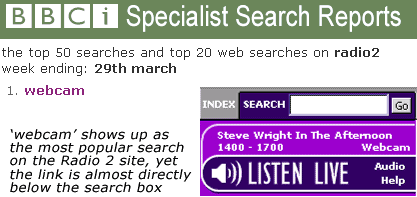How search can help you understand your audience - part 3
This is part 3 of a 4 part article: 1 2 3 4
![]() Download a print version of this article
Download a print version of this article
Using search to spot gaps in content
One area where analysis of search logs can be invaluable is in spotting gaps in content. If a steady stream of visitors come to a site looking for something that is not currently being provided, it makes sense to provide it, or at least provide directions to where the user may be able to find it.
One example of this is the BBC's interactive television programme "Test The Nation", which is a 'National IQ Test' for Britain. The programme is broadcast every few months as a special event, which always causes a peak of searches for 'test the nation', 'iq test', and 'test results'. However we find there is a strong background level of this kind of enquiry throughout the year, regardless of the transmission schedule.
Unfortunately, because of the nature of the show, the actual IQ tests and answers are not available throughout the year - and this gives us a real problem in working out where best to send users looking for time sensitive information that is no longer available. Our solution has been to point the user to press releases about the programme whenever the site is unavailable. This has not been ideal, but is preferable to leaving BBCi users bemused that can find no content about Test The Nation.
Jonathan Creek is another television show that generates a large volume of search queries. Unfortunately in this case BBCi has no content to offer about the programme, and search is unable to help the user, unless we widen the scope of the search to the web outside of BBCi, where several fan sites have stepped into the breach.
This is an example of how, if you cannot or will not provide content yourself about something your users are interested in, you can at least supply avenues of exploration for them to continue their journey.
Using search to highlight potential usability issues
Another area where the examination of search logs can help is to highlight potential usability problems with specific areas of the site. There is an example of this on the BBC's Radio 2 site. We find that 'webcams' is persistently one of the most frequent search terms used from within the site. Yet when we look at the layout of the BBC Radio 2 pages we find that the link to the webcams is just below the search entry box.

This poses three interesting possibilities:
- A significant proportion of users are pre-disposed to search regardless of the navigational provision
- A significant proportion users do not see the 'webcams' link underneath the search box
- A significant proportion users see the 'webcams' link but do realise they can click on it
Now this may not be a serious issue in itself, since by searching for 'webcams' the users in question are still reaching their destination on the site. However it does flag up a concern that users may also not spot or not find clickable the links for 'audio' and 'help'. This is more serious, as we know from our search logs that people don't tend to search for 'audio' and 'help' as abstract concepts, but rather search with specific queries about the 'audio' or 'help' they require. This makes it much less likely that they will receive the right results. There are many of these small issues all around a large web site like the BBC's, and search logs are a valuable tool in making us aware of them.
In the final part of this article I will look at how search logs can help you find out about the diversity in your audience.